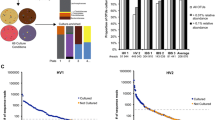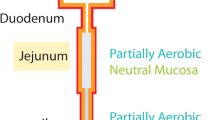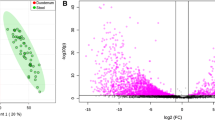Abstract
The aim of this work was to examine by culturing the changes in the total and indicator populations of the feces of two individuals over 1 year and to identify the dominant microbial components of a single sample of feces from each donor. Populations and dominant bacteria from a sample of colonic mucosa from a further individual were also assessed. The culture results were then compared to those obtained with the same samples by 16S rDNA cloning and sequencing. High interindividual variation in representative microbial populations of the gastrointestinal tract (GIT) was revealed by both the culture and the culture-independent techniques. Species belonging to Clostridium clusters (XIVa, IV, and XVIII) predominated in both the fecal and the mucosal samples (except in the mucose cultured isolates), members of Clostridium coccoides cluster XIVa being the most numerous microorganisms. Species of γ -proteobacteria (Escherichia coli and Shigella spp.), bifidobacteria, and actinobacteria appeared in lower numbers than those of clostridia. From the mucosal cultured sample, only facultative anaerobes and bifidobacteria were recovered, suggesting destruction of the anaerobe population during processing. In accordance with this, the microbial diversity revealed by 16S rDNA sequence analysis was greater than that revealed by culturing. Despite large interindividual differences, distinct human communities may have group-associated GIT microbiota characteristics, such as the low number of Bacteroides seen in the subjects in this study.
Similar content being viewed by others
References
Conway PL: Microbial ecology of the human large intestine. In Human Colonic Bacteria: Role in Nutrition, Physiology, and Pathology. GR Gibson, GT Macfarlane (eds). Boca Raton, FL, CRC Press, 1995, pp 1–24
Tannock GW: Analysis of the intestinal microflora: a renaissance. Antonie van Leeuwenhoek 76:265–278, 1999
Gill HS: Stimulation of the immune system. Int Dairy J 8:535–544, 1998
Salminen S, Bouley C, Boutron-Ruault MC, Cummings JH, Franck A, Gibson GR, Isolauri E, Moreau MC, Roberfroid M, Rowland I: Functional food science and gastrointestinal physiology and function. Br J Nutr 80:S147–S171, 1998
Parodi PW: The role of intestinal bacteria in the causation and prevention of cancer: modulation by diet and probiotics. Aust J Dairy Technol 54:103–121, 1999
Hooper LV, Gordon JI: Comensal host-bacteria relationships in the gut. Science 292:115–1118, 2001
Moore WEC, Holdeman LV: Special problems associated with their isolation and identification of intestinal bacteria in fecal flora studies. Am J Clin Nutr 27:1450–1455, 1974
Savage DC: Microbial ecology of the gastrointestinal tract. Annu Rev Microbiol 31:107–133, 1977
Finegold SM, Attebery HR, Sutter VL: Effect of diet on human fecal flora: comparison of Japanese and American diets. Am J Clin Nutr 27:1456–1469, 1974
Noack-Loebel C, Küster E, Rush V, Zimmermann K: Influence of different dietary regimen upon the composition of the human fecal flora. Prog Food Nutr Sci 7:127–131, 1983
McCartney AL, Wang W, Tannock GW: Molecular analysis of the composition of the bifidobacterial and lactobacilli microflora of humans. Appl Environ Microbiol 62:4608–4613, 1996
Wang RF, Cao WW, Cerniglia CE: PCR detection and quantitation of predominant anaerobic bacteria in human and animal fecal samples. Appl Environ Microbiol 62:1242–1247, 1996
Wilson KH, Blitchington RB: Human colonic biota studied by ribosomal DNA sequence analysis. Appl Environ Microbiol 62:2273–2278, 1996
Franks AH, Harmens HJM, Raangs GC, Jansen GJ, Schut F, Welling GW: Variation of bacterial populations in human feces measured by fluorescent in situhybridization with group-specific 16S rRNA-targeted oligonucleotide probes. Appl Environ Microbiol 64:3336–3345, 1998
Zoetendal EG, Akkermans ADL, de Vos WM: Temperature gradient gel electrophoresis analysis of 16S rRNA from human fecal samples reveals stable and host-specific communities of active bacteria. Appl Environ Microbiol 64:3854–3863, 1998
Suau A, Bonnet R, Sutren M, Godon JJ, Gibson GR, Collins MD, Doré J: Direct analysis of genes encoding 16S rRNA from complex communities reveals many novel molecular species within the human gut. Appl Environ Microbiol 65:4799–4807, 1999
Sghir A, Gramet G, Suau A, Rochet V, Pochart P, Doré J: Quantification of bacterial groups within human fecal flora by oligonucleotide probe hybridization. Appl Environ Microbiol 66:2263–2266, 2000
Holdeman LV, Cato EP, Moore WEC: Human fecal flora: variation in bacterial composition within individuals and a possible effect of emotional stress. Appl Environ Microbiol 32:359–375, 1976
Moore WE, Moore LH: Intestinal flora of populations that have a high risk of colon cancer. Appl Environ Microbiol 61:3202–3207, 1995
Hopkins MJ, Sharp R, Macfarlane GT: Age and disease related changes in intestinal bacterial populations assessed by cell culture, 16S rRNA abundance, and community cellular fatty acid profiles. Gut 48:198–205, 2001
Zoetendal EG, Akkermans ADL, Akkermans van-Vliet WM, de Vos WM: The host genotype affects the bacterial community in the human gastrointestinal tract. Microb Ecol Health Dis 13:129–134, 2001
Hayashi H, Sakamoto M, Benno Y: Fecal microbial diversity in a strict vegetarian as determined by molecular analysis and cultivation. Microbiol Immunol 46:819–831, 2002
Koornhof HJ, Richardson NJ, Wall MD, Moore WE: Fecal bacteria in South African rural blacks and other population groups. Isr J Med Sci 15:335–340, 1976
Mackie RI, Sgir A, Gaskins HR: Developmental microbial ecology of the neonatal gastrointestinal tract. Am J Clin Nutr 69:S1035–S1045, 1999
Salminen S, Ouwehand AC, Isolauri E: Clinical applications of probiotic bacteria. Int Dairy J 8:563–572, 1998
Young JPW, Downer HL, Eardly BD: Phylogeny of the prototrophic Rhizobium strain BTAil by polymerase chain reaction-based sequencing of a 16S rRNA segment. J Bacteriol 173:2271–2277, 1991
Altschul SF, Madden TL, Schäffer AA, Zhang J, Zhang Z, Miller W, Lipman DJ: Gapped BLAST and PSI-BLAST: a new generation of protein databases search programs. Nucleic Acids Res 25:3389–3402, 1997
Stackebrandt E, Goebel BM: Taxonomic note: a place for DNA—DNA reassociation and 16S rRNA sequence analysis in the present species definition in bacteriology. Int J Syst Bacteriol 44:846–849, 1994
Wang X, Heazlewood SP, Krause DO, Florin THJ: Molecular characterization of the microbial species that colonize human ileal and colonic mucosa by using 16S rDNA sequence analysis. J Appl Microbiol 95:508–520, 2003
Collins MD, Lawson PA, Willems A, Cördoba JJ, Fernández-Garaizábal J, García P, Cai J, Hippe H, Farrow JA: The phylogeny of the genus Clostridium:proposal of five new genera and eleven new species combinations. Int J Syst Bacteriol 44:812–826, 1994
Mitsuoka T: The human gastrointestinal tract. In The Lactic Acid Bacteria, Vol. 1. The Lactic Acid Bacteria in Health and Disease. BJB Wood (ed). London, Elsevier Applied Science, 1992, pp 69–114
Hayashi H, Sakamoto M, Benno Y: Phylogenetic analysis of the human gut microbiota using 16S rDNA clone libraries and strictly anaerobic culture-based methods. Microbiol Immunol 46:535–548, 2002
Hill MJ: The normal gut bacterial flora. In Role of the Gut Bacteria in Human Toxicology and Pharmacology. MJ Hill (ed). London, Taylor Francis, 1995
Matsuki T, Watanabe K, Fujimoto J, Miyamoto Y, Takada T, Matsumoto K, Oyaizu H, Tanaka R: Development of 16S rRNA-gene-targeted group-specific primers for the detection and identification of predominant bacteria in human feces. Appl Envion Microbiol 68:5445–5451, 2002
Trichopoulou A, Lagiou P: Healthy traditional Mediterranean diet: an expression of culture, history, and lifestyle. Nutr Rev 11:383–389, 1997
Hold GL, Pryde SE, Russell VJ, Furrie E, Flint HJ: Assessment of microbial diversity in human colonic samples by 16S rDNA sequence analysis. FEMS Microbiol Ecol 39:33–39, 2002
Langendijk PS, Schut F, Jansen GJ, Raangs GC, Kamphuis GR, Wilkinson MHF, Welling GW: Quantitative fluorescence in situ hybridization of Bifidobacteriumspp. with genus-specific 16S rRNA-targeted probes and its application in fecal samples. Appl Environ Microbiol 61:3069–3075, 1995
Harmsen HJ, Gibson GR, Elfferich P, Raangs GC, Wideboer-Veloo AC, Argaiz A, Roberfroid MB, Welling GW: Comparison of viable cell counts and fluorescence in situ hybridization using specific rRNA-based probes for the quantification of human fecal bacteria. FEMS Microbiol Lett 183:125–129, 2000
Zoetendal EG, von Wright A, Vilpponen-Salmela T, Ben-Amour K, Akkermans ADL, de Vos WM: Mucosa-associated bacteria in the human gastrointestinal tract are uniformly distributed along the colon and differ from the community recovered from feces. Appl Environ Microbiol 68:3401–4407, 2002
Author information
Authors and Affiliations
Corresponding author
Rights and permissions
About this article
Cite this article
Delgado, S., Suárez, A. & Mayo, B. Identification of Dominant Bacteria in Feces and Colonic Mucosa from Healthy Spanish Adults by Culturing and by 16S rDNA Sequence Analysis. Dig Dis Sci 51, 744–751 (2006). https://doi.org/10.1007/s10620-006-3201-4
Received:
Accepted:
Issue Date:
DOI: https://doi.org/10.1007/s10620-006-3201-4




